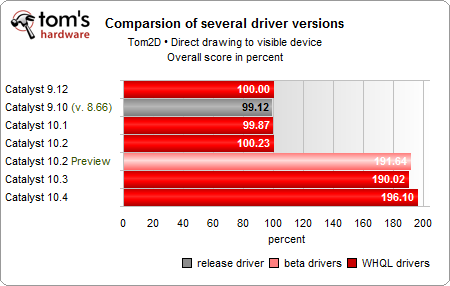AMD: 2D Performance Progress in Windows 7 With Catalyst 10.4?
Not long ago, the 2D performance of newer ATI graphics cards left much to be desired in Windows 7. AMD acknowledged the problem and released new driver versions. We took a closer look at Catalyst 10.4 in order to let you know what has changed.
Trust Is Good, Follow-Up Checks Are Better
Since February and the publication of our 2D benchmark articles 2D, Acceleration, And Windows: Aren't All Graphics Cards Equal? and Part 2: 2D, Acceleration, And Windows: Aren't All Graphics Cards Equal?, we have been looking into the matter a bit more. As you might remember, the results of our performance exploration were concerned with Windows 7 2D performance in GDI-based applications using the newest drivers, as well as the unresolved issues with direct output to a visible display area.
In the initial articles, we referred to the Task Manager paradox. This was one of the reasons why some results were not immediately reproducible, and why measurements on similar systems resulted in different results. We will get to this later.
A Promise is a Promise
The problems we reported were initially met by skepticism from AMD/ATI. However, with the help of the benchmarks and lively internal correspondence with the driver developers, we were happy to see that the bottleneck was both recognized and removed. The reproduction of the problem ultimately led to the optimization of the drivers, as well as AMD publicly announcing that they would actively address this problem.
The release notes for Catalyst 10.4 now promise, among many other improvements and fixes, a performance increase in GDI-based 2D programs and benchmarks under Windows 7. We acknowledge this mention of the word benchmark with a humble smile, because, as a means to an end, it turns out our benchmark Tom2D was quite a useful tool. Let us start with a direct comparison between the different driver versions.
As you can see in the above graph, while presented as new in the Cat. 10.4 release notes, the changes in the drivers were in fact implemented prior to that version. In any case, the driver developers did a splendid job, and we like giving credit where credit is due. We sincerely recommend that users of the affected cards use the newest drivers in Windows 7.
While this pretty much concludes the first matter, we went into more depth and can present you with some rather interesting detailed test results. In addition to these individual comparisons, we will discuss the ‘paradox’ that initially led to incorrect evaluations of the benchmark results over the course of the following pages. Some questions still remain unanswered at this time.
Get Tom's Hardware's best news and in-depth reviews, straight to your inbox.

Igor Wallossek wrote a wide variety of hardware articles for Tom's Hardware, with a strong focus on technical analysis and in-depth reviews. His contributions have spanned a broad spectrum of PC components, including GPUs, CPUs, workstations, and PC builds. His insightful articles provide readers with detailed knowledge to make informed decisions in the ever-evolving tech landscape

